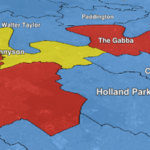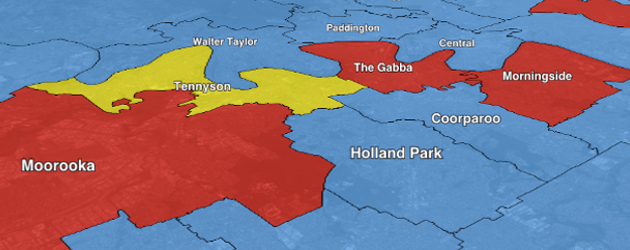 Voters in Queensland will be voting on March 19 in local government elections, along with a referendum on fixed four-year terms for the state Parliament (which I’ve previously blogged about).
Voters in Queensland will be voting on March 19 in local government elections, along with a referendum on fixed four-year terms for the state Parliament (which I’ve previously blogged about).
For the first time, I’ve put together a complete guide to the Brisbane City Council elections, similar to those I’ve done for state and federal elections.
The City of Brisbane is the biggest local government in Australia, with just over 1 million residents. The capital city councils in Sydney, Melbourne, Perth and Adelaide all cover a small inner-city section of the metropolitan area, but Brisbane covers a large expanse, more like big-city governments in places like London, New York or Auckland.
The Lord Mayor of Brisbane is directly elected, making it the biggest election of a single position in Australia. Campbell Newman won the position in 2004 after 13 years of Labor rule, and he was succeeded in 2011 by Graham Quirk, who dominated in 2012, winning a majority in all but one ward and winning 68.5% of the two-party-preferred vote.
The council consists of 26 councillors elected from 26 wards, with each ward not much smaller than a state electorate. The elections are dominated by the major parties. The ALP held a majority on the council during Campbell Newman’s first term, with 17 out of 26 seats on the council. In 2008, the LNP gained seven wards and the council majority. The LNP gained large swings across the council in 2012, and gained a further three wards off the ALP while losing one to an independent, giving them 18 wards.
All of these factors make the council election more like a parliamentary election than like any other local council election, and makes it one worth watching.
The ALP performed poorly in 2008 and 2012, and will be hoping to cut back on LNP council margins and regain a few wards. While Labor would be hoping to set themselves up to win back the council and mayoralty in 2020, it’s hard to see them achieving an overall victory in 2016.




Below is the number and percentage of people in each Brisbane City Council Ward who in the last council elections (2012) had their vote exhausted and not count toward who the winning councillor was – because they didn’t number every square:
Mayoral = 32,147 (7.7%)
Bracken Ridge = 1,075 (4.87%)
Central = 1,796 (8.98%)
Deagon = 1,372 (6.50%)
Enoggera = 1,809 (8.59%)
Hamilton = 1,585 (7.59%)
Holland Park = 1,481 (7.09%)
Jamboree = 858 (4.27%)
Macgregor = 1,784 (9.44%)
Marchant = 1,295 (5.89%)
Moorooka = 1,256 (6.06%)
Pullenvale = 1,545 (6.88%)
Tennyson = 2,578 (12.65%)
The Gabba = 1,719 (8.98%)
The Gap = 2,046 (9.64%)
Toowong = 1,675 (9.25%)
Walter Taylor = 1,396 (7.32%)
Wishart = 1,066 (5.37%)
Wynnum Manly = 2,061 (9.83%)
Make sure your vote counts by Numbering Every Square – http://www.facebook.com/events/1519476985019071/
Source Mayor: http://results.ecq.qld.gov.au/elections/local/LG2012/BrisbaneCity/results/mayoral/summary.html
Source Ward: http://results.ecq.qld.gov.au/elections/local/LG2012/BrisbaneCity/results/councillor/summary.html
This will certainly be an interesting council election. 2012 was really quite exceptional in that there was so much ill-will toward the state ALP, and Ray Smith was a terrible candidate for Lord Mayor. Labor have done far better with their mayoral candidate and campaign this year, so I wouldn’t be surprised to see a city-wide swing of 10-14%. I just don’t feel there’s enough hatred of the LNP around to give it as much of a bashing as the 2015 state election.
Doboy, Central and Holland Park are almost certainly lost, and I’d give Labor a good chance in Enoggera. Coorparoo and Paddington will be very tight, but I think while the LNP will only hold onto at least one of them.
It’ll be interesting to see what happens with Nicole Johnston in Tennyson. As a former constituent of hers (although still registered there), she was never an especially active member (even before she left the LNP). Plus the new boundaries will favour the LNP more. She might hold on with greater Labor and Greens preferences, but I’d expect her primary to go backwards.
Another interesting point will see if the Greens can improve on their 2012 results. They’ve actually got the most sensible transport policies of all three parties at this election.
Success for them would see them hold onto their second place finishes in Pullenvale and Walter Taylor and possibly gain another (The Gap being the most likely target, followed by the likes of Paddington, Central and Hamilton).
In the mayoral election, if they get 12%, that’ll be a successful night given Labor’s improvement over the past four years.
I agree with you Macca-GC. Saturday night will see a big swing to Labor in both the wards and the mayoralty.
If the swing to Labor continues to build in the last week of this campaign they will be on track to win at least 5 wards and possibly more. It would not surprise me if there are larger swings against the LNP in there safer wards due to concerns over public transport and increased development to residential areas.
I believe Nicole Johnston will be reelected as the Councillor for Tennyson ward and her support could be crucial for the next elected administration at City Hall.
Expect this election to be like the 2009 State Election. I suspect Harding will all the right swings in all the wrong places and leave them more or less where they started. This will be much ado about nothing.
Comments are closed.